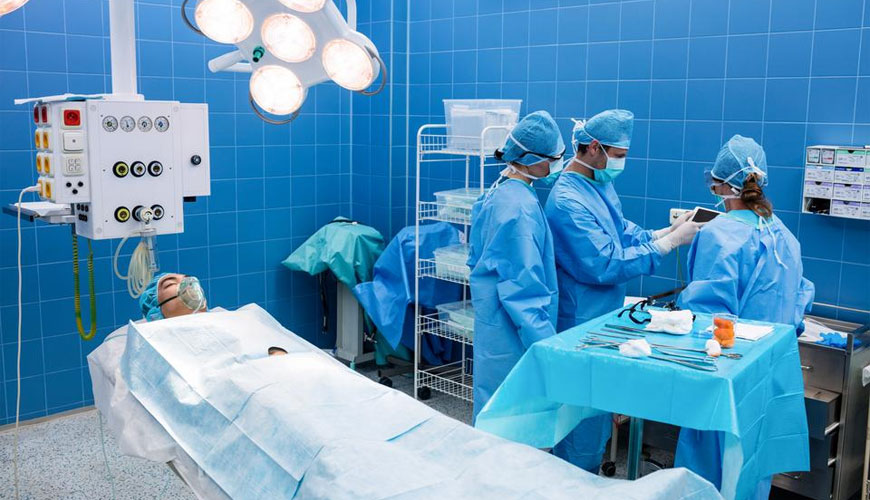

EUROLAB laboratory provides testing and compliance services within the scope of ISO 16604 standard. The ISO 16604 standard, developed by the International Standards Organization (ISO), describes a laboratory test method for measuring the resistance of materials used in protective clothing to the penetration of blood-borne pathogens. This test method uses a surrogate microbe under conditions of continuous liquid contact.

Protective clothing "pass/fail" determinations are based on the detection of viral penetration at a given hydrostatic pressure using the ISO 13994 tester. This test method is not always effective for testing protective clothing materials with thick, inner linings that easily absorb tough liquid.
This test method involves a sensitive assay procedure. Due to the length of time required to complete this test method, the material or protective clothing may not be suitable for use as a quality control or assurance procedure.
Persons involved in the treatment and care of injured or sick individuals, especially healthcare professionals, may be exposed to infectious biological fluids. These diseases, which can be caused by various microorganisms, can pose significant risks to life and health. This is especially true for blood-borne viruses that cause hepatitis [hepatitis B virus (HBV) and hepatitis C virus (HCV)] and acquired immune deficiency syndrome (AIDS) [human immunodeficiency viruses (HIV)]. Consideration is given to reducing the potential for direct skin contact through the use of protective clothing, as engineering controls cannot eliminate all possible exposures.
This International Standard deals with protective clothing and associated protective devices designed to protect against the ingress of blood or bodily fluids. Given the diversity of healthcare environments, activities, and potential for exposure to blood or body fluids, barrier requirements for protective clothing materials will change with application.
This test method does not apply to all forms or conditions of bloodborne pathogen exposure. Users of this test method should review their worker/clothing exposure modes and evaluate the suitability of this test method for their particular application. This test method has been specifically described to model the viral penetration of hepatitis (B and C) and human immunodeficiency viruses transmitted in blood and other potentially infectious body fluids. The surrogate microbe Phi-X174 bacteriophage used in this test method is similar in size and shape to HCV, but also acts as a surrogate for HBV and HIV. Implications for protection from other pathogens should be evaluated on a case-by-case basis.
This test method only considers the performance of materials used in protective clothing or of certain material structures (eg seams). This test method does not consider the design, overall construction and components or interfaces of the garments or other factors that may affect the overall protection afforded by the protective clothing. It is emphasized that the test does not have to simulate the conditions that clothing materials are likely to be exposed to in practice. Therefore, the use of test data should be limited to broad comparative evaluation of such materials with respect to their viral penetration resistance properties.
Testing before the protective barrier is deteriorated by physical, chemical and thermal stresses that can adversely affect its performance can lead to a false sense of security. Consider tests that evaluate the effect of sterilization, storage conditions, and shelf life on penetration resistance for disposable products, and the effects of washing and sterilization on penetration resistance for reusable products. The integrity of the protective barrier may also be compromised by effects such as stretching and abrasion during use. It is also possible for pre-wetting to compromise the integrity of the protective barrier by contaminating materials such as alcohol and sweat. If these conditions are of concern, evaluate the performance of protective clothing materials for Phi-X174 bacteriophage penetration following an appropriate preconditioning technique that represents the expected conditions of use.
Medical protective clothing materials are intended to be a barrier against blood, body fluids and other potentially infectious materials. Many factors can affect the wetting and penetration properties of body fluids, such as surface tension, viscosity and polarity of the fluid, as well as the structure and relative hydrophilicity or hydrophobicity of materials. The surface tension range for blood and body fluids (excluding saliva) is about 0,042 N/m to 0,060 N/m. To help simulate the wetting properties of blood and body fluids, the surface tension of the Phi-X174 bacteriophage loading suspension is adjusted to approach the lower end of this surface tension range. The obtained surface tension of the Phi-X174 bacteriophage loading suspension was (0,042 ± 0,002) N/m.
Part of this method for exposing protective clothing material samples with Phi-X174 bacteriophage loading suspension involves pressurizing the test cell to 14,0 kPa (in Procedures A and B). This hydrostatic pressure has been documented to produce test results that correlate with visual penetration results obtained with human factors verification. However, some studies suggest that mechanical pressures in excess of 345 kPa may occur during clinical use. Therefore, it is important to understand that this test method does not simulate all the physical stresses and pressures applied to protective clothing garments during actual use. Procedures C and D use a stepped pressurization approach with pressures up to 20,0 kPa. These procedures simulate a range of possible pressures to rank material performance.
Among the services provided by our organization within the framework of material testing services, there are also ISO 16604 standard tests. Do not hesitate to contact our laboratory EUROLAB for your testing and certification requests.
To get an appointment, to get more detailed information or to request an evaluation, you can ask us to fill in our form and reach you.